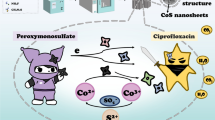Abstract
An aerobic bacterial strain, designated R04, belonging to the genus Rhodococcus has been isolated and characerized by 16S rDNA analysis. The capability of this strain to degrade seven different polychlorinated biphenyls (CBs), 500 ppm 3-CB, 3,4-CB, 4,4′-CB, 2,4,6-CB, 2,4′,5-CB, 2,3,4,5-CB and 3,4,3′,4′-CB in liquid medium, was evaluated. After 5 days of incubation, the concentration of chloride increased to 0.35 mM in cultures containing 3-CB and R04, whereas in cultures with 3,4-CB, 2,3,4,5-CB or 3,4,3′,4′-CB plus R04 the chloride content increased to 0.1 mM. However, non-stoichiometric amounts of chloride were produced in cultures with R04 and 4,4′-CB, 2,4,6-CB and 2,4′,5-CB. The spectrum of supernatants from R04 grown on seven PCBs had a UV-visible (UV-VIS) absorption at 200–500 nm, characteristic of biphenyl-derived cleavage products. Gas-chromatographic (GC) analysis showed that R04 was able to transform 100% of 3-CB and 3,4-CB after 1 day of incubation, and 95% of 4,4′-CB, 2,4,6-CB, 2,4′,5-CB, 2,3,4,5-CB and 3,4,3′,4′-CB after 5 days of incubation. The position of the chlorine substituents on the rings strongly influenced the degradation of polychlorinated biphenyls (PCBs) and their intermediate metabolites by Rhodococcus sp. R04. The degradation of PCBs was further evaluated by monitoring intermediate metabolites of PCBs.





Similar content being viewed by others
Abbreviations
- PCB:
-
Polychlorinated biphenyl
- CB:
-
Chlorinated biphenyl
- MM:
-
Minimal medium
- YBCP:
-
Yellow biphenyl-derived cleavage product
References
Abramowicz DA (1990) Aerobic and anaerobic biodegradation of PCBs: a review. Crit Rev Biotechnol 10:241–300
Arensdorf JJ, Focht DD (1994) Formation of chlorocatechol meta cleavage products by a pseudomonad during metabolism of monochlorobiphenyls. Appl Environ Microbiol 60:2884–2889
Arensdorf JJ, Focht DD (1995) A meta cleavage pathway for 4-chlorobenzoate, an intermediate in the metabolism of 4-chlorobiphenyl by Pseudomonas cepacia P116. Appl Environ Microbiol 61:443–447
Asturias JA, Timmis KN (1993)Three different 2,3-dihydroxybiphenyl-1,2-dioxygenase genes in the gram-positive polychlorobiphenyl-degradingbacterium Rhodococcus globerulus P6. J Bacteriol 175:4631–4640
Barton MR, Crawford RL (1988) Novel biotransformations of 4-chlorobiphenyl by a Pseudomonas sp. Appl Environ Microbiol 54:594–595
Bedard DL (1986) Rapid assay for screening and characterizing microorganisms for the ability to degrade polychlorinated biphenyls. Appl Environ Microbiol 51:761–768
Bedard DL, Unterman R, Bopp LH, Brennan MJ, Haberl ML, Johnson C (1986) Rapid assay for screening and characterizing microorganisms for the ability to degrade polychlorinated biphenyls. Appl Environ Microbiol 51:761–768
Chung SY, Maeda M, Song E, Horikoshi K, Kudo T (1994) Isolation and characterization of a Gram-positive polychlorinated biphenyl-degradingbacterium, Rhodococcus erythropolis strain TA421, from a termite ecosystem. Biosci Biotechnol Biochem 58:2111–2113
Lauber JD (1986) Disposal and destruction of waste PCBs. In: Waid JS (eds) PCBs and the environment, vol III. CRC Press, Boca Raton, pp 83–151
Mhiri C, de Marsac NT (1997) Réhabilitation par les microorganisms de sites contenant du pyralène. Bull Inst Pasteur 95:3–28
Robinson GK, Len MJ (1994) The bioremediation of polychlorinated biphenyls (PCBs): problems and perspectives. Biotechnol Gen Eng Rev 12:139–188
Sanggoo K, Flynn WP (2000) Anovel bacterium that utilizes monochlorobiphenyls and 4-chlorobenzoate as growth substrates. FEMS Microbiol Lett 185:225–229
Seto M, Kimbara K, Shimura M, Hatta T, Fukuda M, Yano K (1995) A novel transformation of polychlorinated biphenyls by Rhodococcus sp. strain RHA1. Appl Environ Microbiol 61:3353–3358
Sierra I, Valera JL, Marina ML, Laborda F (2003) Study of the biodegradation process of polychlorinated biphenyls in liquid medium and soil by a new isolated aerobic bacterium (Janibacter sp). Chemosphere 53:609–618
Strand SE (1990) Aerobic biodegradation of polychlorinated biphenyls. CEWA, ESC, MICRO 518:1–10
Sylvestre M (1995) Biphenyl/chlorobiphenyls catabolic pathways of Commamonas testosterone B356: prospect for use in bioremediation. Int Biodeterior Biodegrad 35:189–211
Unterman R, Bedard DL, Brennan MJ, Bopp LH, Mondello FJ, Brooks RE, Mobley DP, McDermott JB (1988) Biological approaches for PCB degradation. In: Omenn GS et al (eds) Reducing risks from environmental chemicals through biotechnology. Plenum, New York, pp 253–269
Wang Y, Garnon J, Labbe D, Bergeron H, Lau PC (1995) Sequence and expression of the bpdC1C2BADE genes involved in the initial steps of biphenyl/chlorobiphenyl degradation by Rhodococcus sp. M5. Gene 164:117–122
Yoon JH, Kang SS, Cho YG (2000) Rhodococcus pyridinivorans sp. nov., a pyridine-degrading bacterium. Int J Syst Evol Microbiol. 6:2173–2180
Zhang WZ, Xue YF, Ma YH (2000) Marinospirillum alkaliphilum sp. nov., a new alkaliphilic helical bacterium from Haoji soda lake in inner Mongolia autonomous region of China. Extremophiles 6:33–37
Acknowledgements
This project was supported by a grant from the National High Technology Program of China (2002 AA 601170). We thank Professor Janice Willson for critically reading the manuscript.
Author information
Authors and Affiliations
Corresponding author
Rights and permissions
About this article
Cite this article
Yang, X., Sun, Y. & Qian, S. Biodegradation of seven polychlorinated biphenyls by a newly isolated aerobic bacterium (Rhodococcus sp. R04). J IND MICROBIOL BIOTECHNOL 31, 415–420 (2004). https://doi.org/10.1007/s10295-004-0162-5
Received:
Accepted:
Published:
Issue Date:
DOI: https://doi.org/10.1007/s10295-004-0162-5




